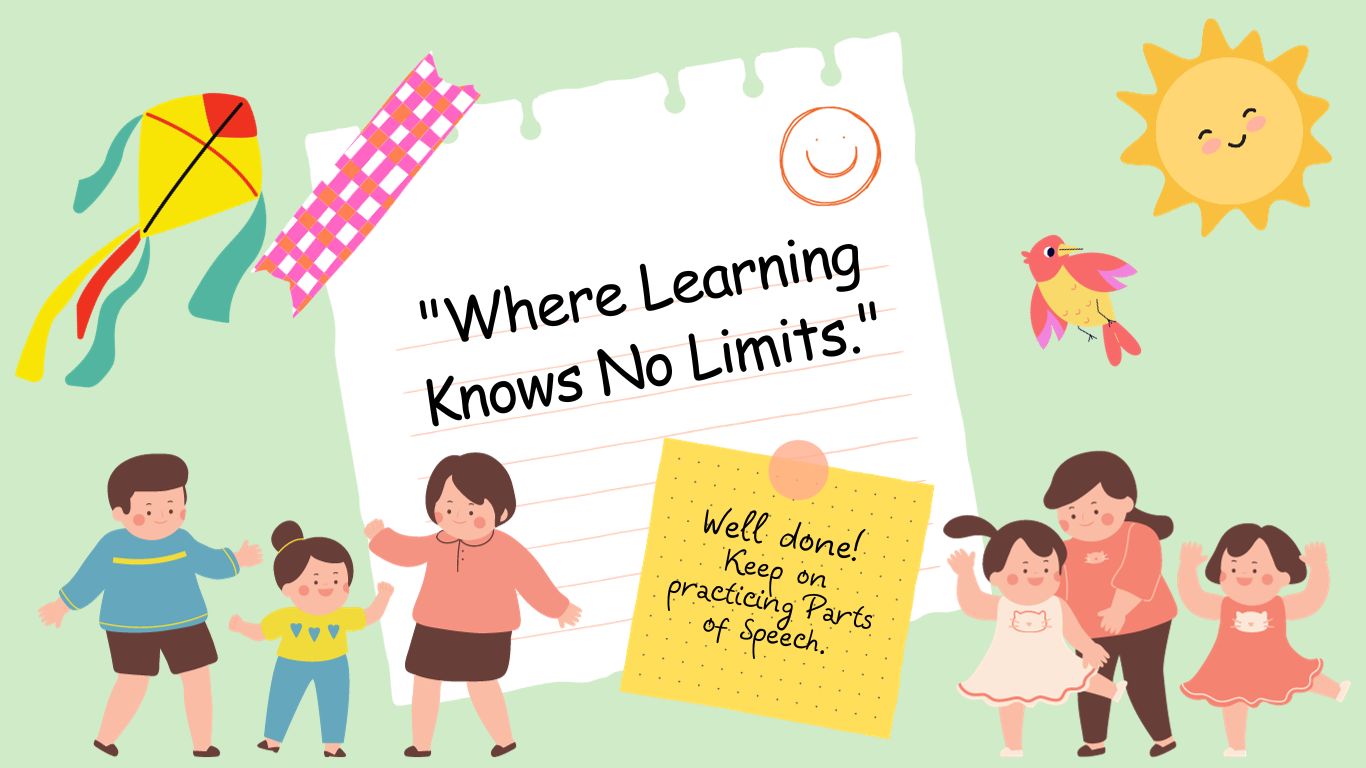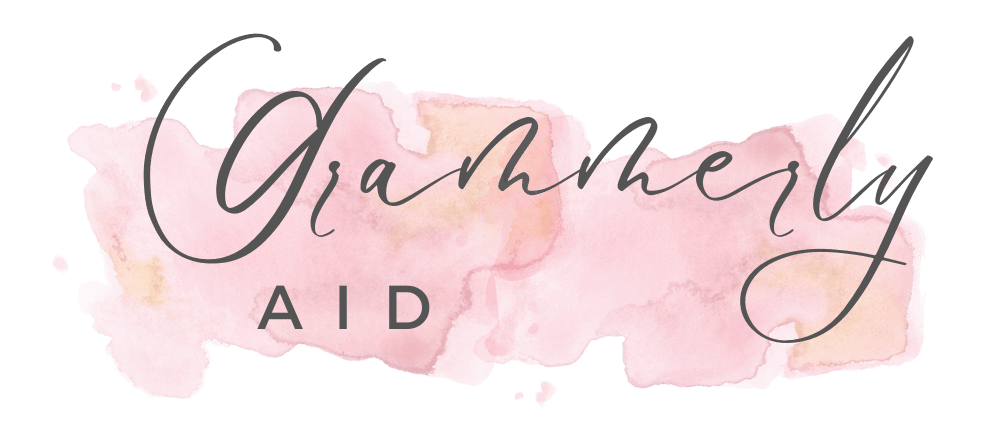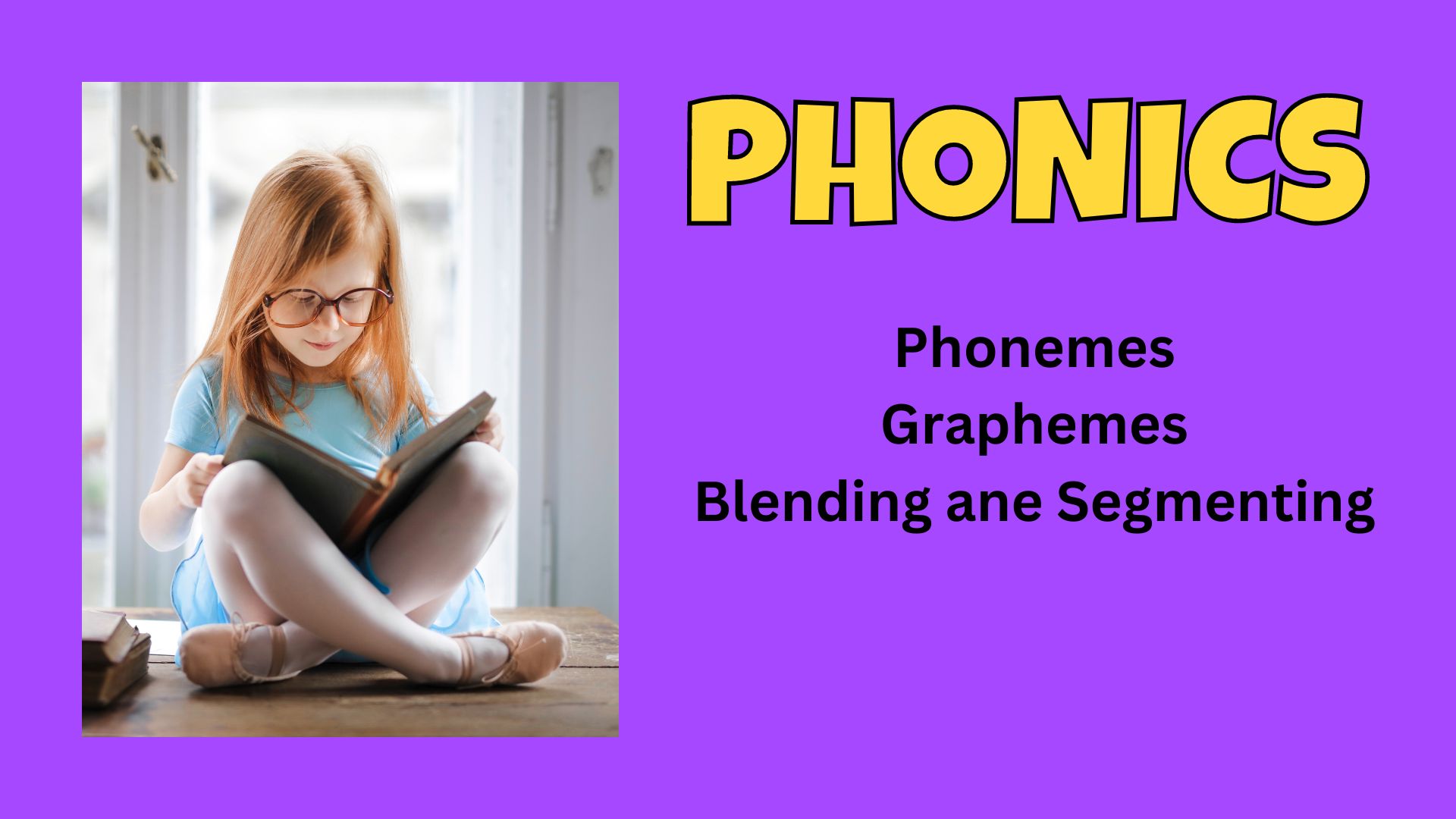Welcome to the amazing world of phonics, where magic can be brought into letters and sounds! Phonics is an approach to teaching reading and writing. It does so by developing in the learner an awareness of phonemes—the smallest units of sound that make up words. Through phonics, they learn the connection of these sounds with their corresponding letters to ultimately provide them with the skills to decode unknown words and spell them correctly, reading more fluently.
Introduction to Phonics
Phonics is a method used to teach reading and writing by correlating sounds (phonemes) with symbols (graphemes or letters). It helps learners understand the relationship between letters and their corresponding sounds in spoken language, facilitating the ability to decode words and spell accurately.
Example of Phonics:
In phonics instruction, students learn that the letter “b” corresponds to the sound /b/. They apply this knowledge to read words like “bat” (/b/ + /a/ + /t/ = bat) and to spell words like “bat”‘.
Phonics Components:
Phonemes:
- Definition: What phonemes are and their role in phonics.
- Types: Discuss different phonemes, including consonants and vowels, and their variations (e.g., short vowels, long vowels, diphthongs).
Graphemes:
- Definition: Explain graphemes and their relationship to phonemes.
- Examples: Provide examples of how different graphemes represent the same phoneme (e.g., “sh” for /ʃ/, “ch” for /tʃ/).
Blending and Segmenting:
- Blending: Describe how phonics instruction teaches blending sounds to form words.
- Segmenting: Explain how segmenting helps in breaking down words into individual phonemes.

Phonemes:
Definition: Phonemes are individual sounds that make up words. They are distinct units of sound that can change the meaning of a word when substituted for another phoneme. In English phonetics, there are approximately 44 phonemes, which are the basic units of sound that distinguish one word from another. Here is a detailed list of the 44 phonemes in the English language along with examples and brief descriptions:
Types of Phonemes:
- Vowel Phonemes: These are produced without any significant constriction of the airflow in the vocal tract (e.g., /a/, /e/, /i/, /o/, /u/).
- Consonant Phonemes: These involve some degree of closure or constriction in the vocal tract (e.g., /b/, /d/, /g/, /s/, /t/).
Vowel Phonemes (20):
are the distinct sounds produced by vowels that function to differentiate words in a language. Each vowel sound is a phoneme if it can change the meaning of a word when substituted with another vowel sound. Vowel phonemes are crucial for accurate pronunciation and comprehension in spoken language.
Short Vowel Sounds (5):
These are typically found in closed syllables (syllables ending in a consonant).

/æ/ – A as in:
- cat
- bat
- hat
/ɛ/ – E as in:
- bed
- met
- pen
/ɪ/ – I as in:
- sit
- hit
- pin
/ɒ/ or /ɑ/ – O as in:
- cot
- hot
- dog
/ʌ/ – U as in:
- cut
- bus
- mud
Long Vowel Sounds (5):
These are typically found in open syllables (syllables ending in a vowel) or in syllables where the vowel is followed by a single consonant and a silent “e.”
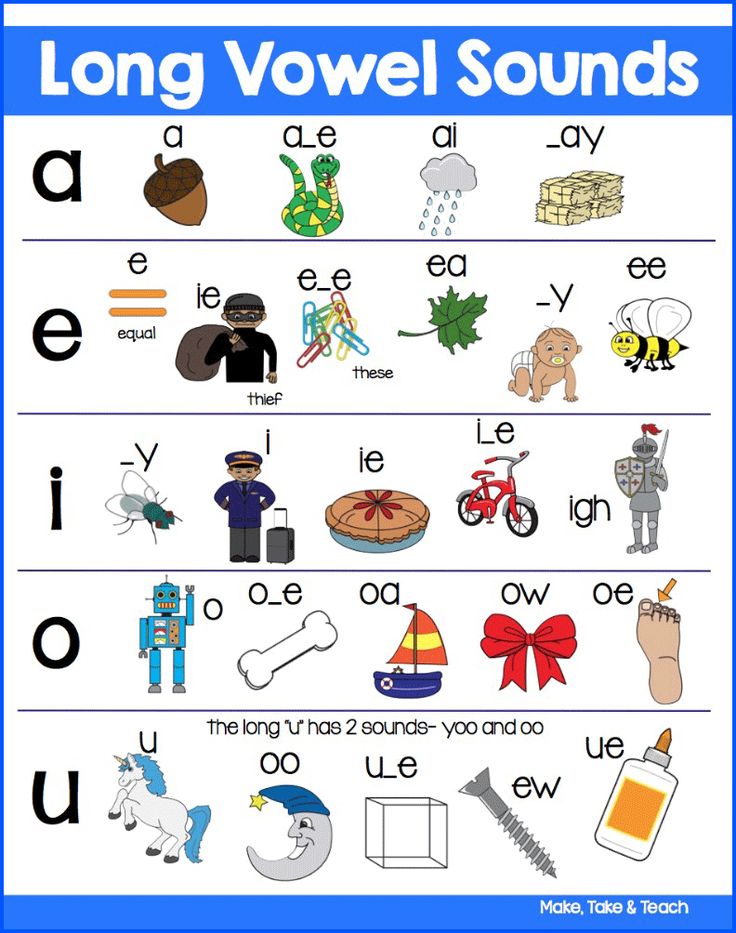
/eɪ/ – A as in:
- cake
- mate
- name
/iː/ – E as in:
- beet
- meet
- seal
/aɪ/ – I as in:
- kite
- bike
- time
/oʊ/ or /əʊ/ – O as in:
- bone
- home
- go
/juː/ or /uː/ – U as in:
- flute
- mule
Diphthong:
Diphthongs are complex vowel sounds where the tongue moves from one vowel position to another within the same syllable. In English, diphthongs often involve a combination of two vowel sounds and can be represented by specific letters or combinations of letters. Here are the common diphthong sounds with their corresponding letters and example words:
Diphthong Sounds (8):
- /eɪ/ – A as in:
- bait
- rain
- cake
- /aɪ/ – I as in:
- bite
- light
- kite
- /ɔɪ/ – OI, OY as in:
- coin
- boy
- toy
- /aʊ/ – OU, OW as in:
- out
- cow
- house
- /oʊ/ or /əʊ/ – O, OA, OW as in:
- goboatsnow
- /ɪə/ – EAR, IER as in:
- ear
- dear
- pier
- /eə/ – AIR, ARE as in:
- air
- care
- fair
- /ʊə/ – URE, OUR as in:
- pure
- tour
- cure
R-controlled vowels (5):
R-controlled vowels (also known as “bossy R” vowels) occur when a vowel is followed by the letter “R,” which changes the way the vowel is pronounced. Instead of having its usual short or long sound, the vowel becomes influenced or “controlled” by the “R,” resulting in a unique sound.
R-Controlled Vowel Sounds:
/ɑr/ – AR as in:
- car
- star
- art
/ɛr/ – ER as in:
- her
- term
- fern
/ɪr/ – IR as in:
- bird
- stir
- girl
/ɔr/ – OR as in:
- for
- corn
- storm
/ʊr/ or /ɜr/ – UR as in:
- fur
- hurt
- curl
Consonant phonemes (24):
Consonant sounds are speech sounds that are produced by partially or completely blocking the airflow in the vocal tract, creating audible friction, closure, or release. Unlike vowel sounds, which are produced with an open vocal tract, consonant sounds involve specific articulatory movements where the tongue, lips, teeth, and other parts of the mouth come into contact or come close together to create various sounds.
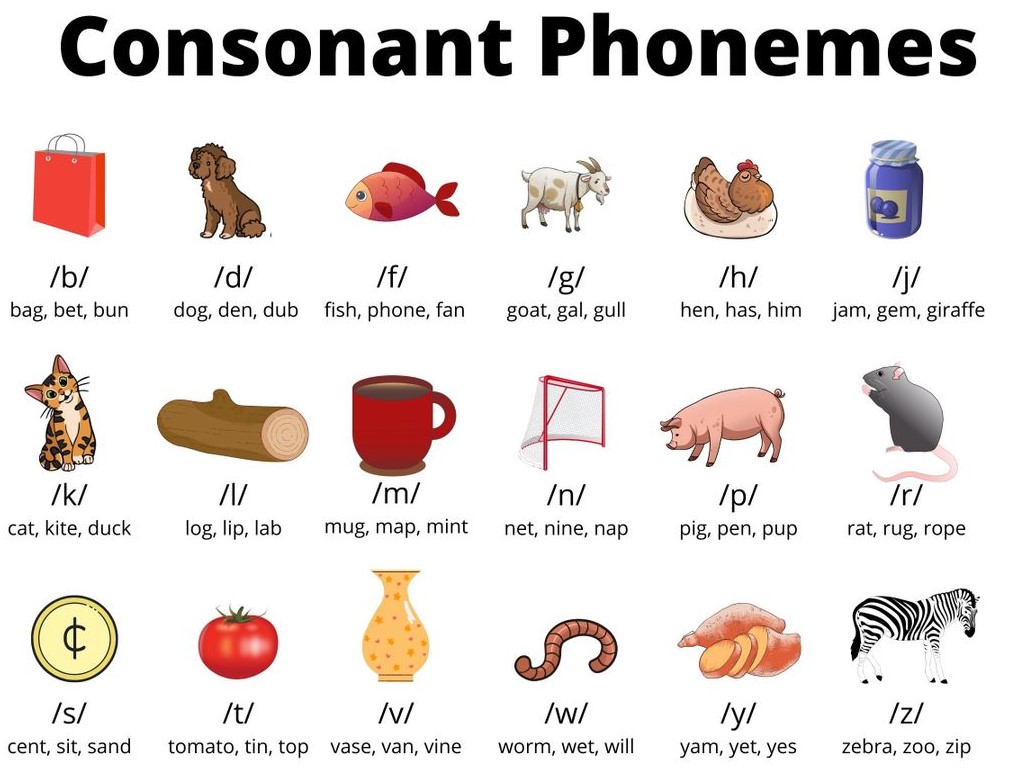
Plosive Sounds (6) :
These are produced by completely blocking the airflow and then releasing it .
- /p/ as in “pen”
- /b/ as in “bat”
- /t/ as in “top”
- /d/ as in “dog”
- /k/ as in “cat”
- /g/ as in “go”
Fricative Sounds (9):
are a type of consonant sound produced by forcing air through a narrow constriction in the vocal tract, creating audible friction.
- /f/ as in “fish”
- /v/ as in “van”
- /θ/ as in “think”
- /ð/ as in “this”
- /s/ as in “sit”
- /z/ as in “zip”
- /ʃ/ as in “ship”
- /ʒ/ as in “measure”
- /h/ as in “hat”
Affricate Sounds (2):
These begin as plosives and release as fricatives.
- /tʃ/ as in “chat”
- /dʒ/ as in “jam”
Nasal Sounds (3):
These are produced by blocking the oral cavity and allowing air to flow through the nose (e.g., /m/, /n/, /ŋ/ as in “sing”).
- /m/ as in “man”
- /n/ as in “net”
- /ŋ/ as in “sing”
Approximant Sounds (4):
are a type of consonant sound in which the articulators (such as the tongue, lips, or palate) approach each other, but not closely enough to create turbulent airflow, as happens with fricatives.
- /r/ as in “red”
- /l/ as in “leg”
- /j/ as in “yes”
- /w/ as in “wet”
Graphemes:
Definition:
Graphemes are the written symbols (letters or groups of letters) that represent phonemes (sounds) in a language. Here’s a list of common graphemes in English along with their corresponding sounds.

- Single Letter Graphemes
- A/a
- Sound: /æ/ as in “cat”
- B/b
- Sound: /b/ as in “bat”
- C/c
- Sound: /k/ as in “cat” or /s/ as in “cent”
- D/d
- Sound: /d/ as in “dog”
- E/e
- Sound: /ɛ/ as in “bed”
- F/f
- Sound: /f/ as in “fish”
- G/g
- Sound: /g/ as in “go” or /dʒ/ as in “gem”
- H/h
- Sound: /h/ as in “hat”
- I/i
- Sound: /ɪ/ as in “sit” or /aɪ/ as in “like”
- J/j
- Sound: /dʒ/ as in “jam”
- K/k
- Sound: /k/ as in “kite”
- L/l
- Sound: /l/ as in “leg”
- M/m
- Sound: /m/ as in “man”
- N/n
- Sound: /n/ as in “net”
- O/o
- Sound: /ɒ/ as in “hot” or /oʊ/ as in “go”
- P/p
- Sound: /p/ as in “pen”
- Q/q
- Sound: /kw/ as in “queen”
- R/r
- Sound: /r/ as in “red”
- S/s
- Sound: /s/ as in “sun” or /z/ as in “has”
- T/t
- Sound: /t/ as in “top”
- U/u
- Sound: /ʌ/ as in “cup” or /juː/ as in “cute”
- V/v
- Sound: /v/ as in “van”
- W/w
- Sound: /w/ as in “wet”
- X/x
- Sound: /ks/ as in “box” or /z/ as in “xylophone”
- Y/y
- Sound: /j/ as in “yes”
- Z/z
- Sound: /z/ as in “zip”
- Digraphs and Combined Graphemes
- Th/th
- Sound: /θ/ as in “think” or /ð/ as in “this”
- Sh/sh
- Sound: /ʃ/ as in “ship”
- Ch/ch
- Sound: /tʃ/ as in “chat”
- Wh/wh
- Sound: /w/ as in “what”
- Ng/ng
- Sound: /ŋ/ as in “sing”
- Ph/ph
- Sound: /f/ as in “phone”
- Ck/ck
- Sound: /k/ as in “back”
- Er/er
- Sound: /ɜːr/ as in “fern”
- Ow/ow
- Sound: /aʊ/ as in “cow”
- Oi/oi
- Sound: /ɔɪ/ as in “coin”
- Au/au
- Sound: /ɔː/ as in “caught”
- Oo/oo
- Sound: /uː/ as in “food”
- Ea/ea
- Sound: /iː/ as in “tea” or /ɛ/ as in “head”
- Ai/ai
- Sound: /eɪ/ as in “rain”
- Ie/ie
- Sound: /aɪ/ as in “pie”
- Ee/ee
- Sound: /iː/ as in “see”
- Oi/oi
- Sound: /ɔɪ/ as in “coin”
- Silent Graphemes
- Kn/kn
- Sound: /n/ (silent) as in “knight”
- Gn/gn
- Sound: /n/ (silent) as in “gnat”
- Wr/wr
- Sound: /r/ (silent) as in “wrist”
Digraphs:
Definition: A digraph is a combination of two letters that together represent a single sound (phoneme) in a word. This sound is often different from the individual sounds that each letter would make on its own. Digraphs can be made up of two consonants, two vowels, or a combination of a consonant and a vowel. They are a common feature in many languages, including English, where they are used to represent specific sounds that do not have a one-to-one correspondence with individual letters.
Types of Digraphs:
- Consonant Digraphs:
- Consonant digraphs consist of two consonants that come together to represent a single consonant sound. In many cases, the sound produced by a consonant digraph is different from the sounds that the individual letters would produce if they were spoken separately.
- /ch/: as in chip, cheese, child (represents the /tʃ/ sound)
- /sh/: as in ship, shoe, push (represents the /ʃ/ sound)
- /th/: as in think, this, bath (represents the /θ/ sound as in “think” or the /ð/ sound as in “this”)
- /wh/: as in whale, whip, what (represents the /ʍ/ or /w/ sound)
- /ph/: as in phone, elephant, graph (represents the /f/ sound)
- /ck/: as in duck, back, clock (represents the /k/ sound)
- /ng/: as in sing, long, song (represents the /ŋ/ sound)
2.Vowel Digraphs:
- Vowel digraphs consist of two vowels that come together to produce a single vowel sound. The sound produced can be a long vowel sound, a short vowel sound, or sometimes even a diphthong.
Common Vowel Digraphs:
- /ai/: as in rain, train, paid (represents the long /eɪ/ sound)
- /ea/: as in seat, meat, team (usually represents the long /iː/ sound, but can also represent the short /ɛ/ sound as in head)
- /oa/: as in boat, goat, road (represents the long /oʊ/ or /əʊ/ sound)
- /ee/: as in see, tree, need (represents the long /iː/ sound)
- /oo/: as in book, look, good (represents the /ʊ/ sound) or moon, soon, food (represents the /uː/ sound)
- /ou/: as in out, loud, about (represents the /aʊ/ sound), or soup, group (represents the /uː/ sound)
- /ie/: as in pie, tie, lie (represents the long /aɪ/ sound)
- /ue/: as in blue, glue, true (represents the /uː/ sound)
3.Consonant-Vowel Digraphs:
- Sometimes, a consonant and a vowel together create a unique sound that is different from the sound that the letters would normally make.
Examples of Consonant-Vowel Digraphs:
- /qu/: as in quick, queen, quiet (represents the /kw/ sound)
- /gu/: as in guess, guitar (where the “u” is often silent but sometimes influences pronunciation)
R-Controlled Vowels:
Definition:
Vowels that are followed by the letter “r” and have a modified sound.
R-Controlled Vowels (5):
- /ar/ as in “car”
- Definition: Vowel sound controlled by “r”
- Examples: car, star, far
- /er/ as in “her”
- Definition: Vowel sound controlled by “r”
- Examples: her, fern, verb
- /ir/ as in “bird”
- Definition: Vowel sound controlled by “r”
- Examples: bird, girl, first
- /or/ as in “fork”
- Definition: Vowel sound controlled by “r”
- Examples: fork, sort, north
- /ur/ as in “turn”
- Definition: Vowel sound controlled by “r”
- Examples: turn, burn, curl
Blending and Segmenting:
Blending and segmenting are fundamental phonics skills that help learners understand how individual sounds (phonemes) come together to form words and how words can be broken down into their constituent sounds. Both are essential for developing reading and spelling abilities.
Blending:
Definition: Blending is the process of combining individual phonemes to pronounce a word. It involves smoothly running together the separate sounds to form a whole word.
How Blending Works:
- Sound Identification:
- Students identify the individual phonemes in a word. For example, the word “cat” consists of the sounds /k/, /æ/, and /t/.
- Combining Sounds:
- Students blend these sounds together to pronounce the word. The process involves holding each sound briefly and then merging them without significant pauses.
Examples of Blending:
- Simple CVC Words:
- /c/, /a/, /t/ → cat
- /d/, /o/, /g/ → dog
- Words with Blends:
- /bl/, /u/, /e/ → blue
- /str/, /e/, /et/ → street
- Words with Digraphs:
- /sh/, /o/, /p/ → shop
- /ch/, /a/, /t/ → chat
Segmenting:
Definition:
Segmenting is the process of breaking a word down into its individual phonemes. It involves identifying and isolating the sounds within a word.
How Segmenting Works:
- Word Analysis:
- Students listen to or visualize a word and break it down into its component sounds.
- Sound Isolation:
- Students separate the sounds of the word, often using techniques like tapping or counting each sound.
Examples of Segmenting:
- Simple CVC Words:
- cat → /k/, /æ/, /t/
- dog → /d/, /o/, /g/
- Words with Blends:
- blue → /b/, /l/, /u/, /e/
- street → /s/, /t/, /r/, /e/, /t/
- Words with Digraphs:
- shop → /sh/, /o/, /p/
- chat → /ch/, /a/, /t/
conclusion:
Phonics is a cornerstone of early literacy instruction, providing a systematic approach to understanding how letters and sounds interact to form words. By focusing on the relationship between phonemes (sounds) and graphemes (letters or letter combinations), phonics equips learners with essential skills for decoding and encoding language. This foundational knowledge is critical for developing reading fluency, spelling accuracy, and overall language comprehension.
